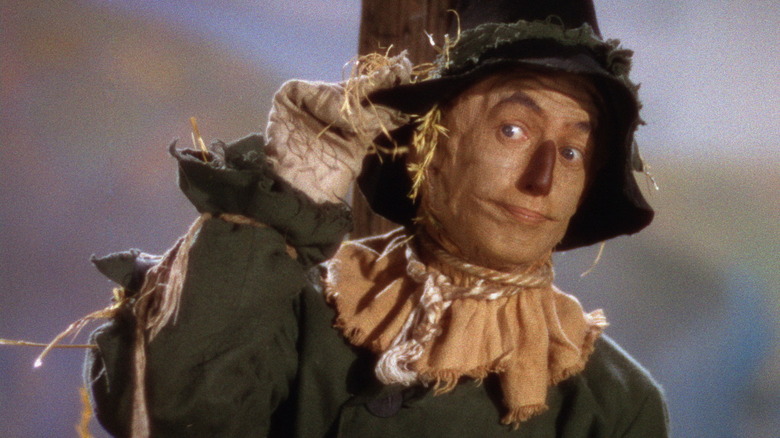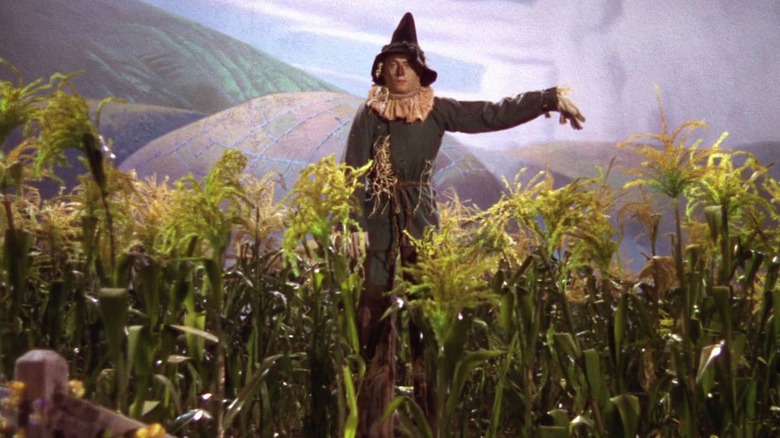Intense Make Up In The Wizard Of Oz Left One Actor With Permanent Marks
It's well known to fans of "The Wizard of Oz" that actor Ray Bolger was originally cast to play the Tin Man and famed comedian Buddy Ebsen was cast as the Scarecrow. They swapped roles at Bolger's insistence, as Bolger had a personal attachment to the role; he was inspired to become an actor after seeing Vaudevillian Fred Stone play the part on stage when Bolger was a child. Ebsen was fine with changing roles, although he had to drop out of production due to makeup problems. The silvery Tin Man makeup contained powered aluminum and Ebsen breathed in big clouds of it, making him sick. At the time, many merely assumed Ebsen had an allergy. Ebsen was replaced with Jack Haley, and the makeup was altered to be a paste instead of a powder.
With the possible exception of "Star Wars," no film's production has been more meticulously recorded and archived than that of "The Wizard of Oz," itself based loosely on the Oz books by L. Frank Baum. Victor Fleming, the credited director, oversaw most of the production of "Oz," while an uncredited King Vidor directed the sepia-tone sequences. Additionally, Norman Taurog, Richard Thorpe, George Cukor, and Mervyn LeRoy also worked brief stints as the film's director.
Aljean Harmetz's 1989 book "The Making of the Wizard of Oz" is one of the better-known behind-the-scenes books about the MGM classic, and it contains a story about Bolger's Scarecrow makeup that is just as harrowing as the aluminum dust incident with Buddy Ebsen. The Scarecrow makeup was a latex mask, a novelty at the time, and had to be glued to Bolger's face in a long and presumably uncomfortable process.
The hard part, however, was peeling it off at the end of the day.
The rubber bag
Harmetz's book refers to Bolger's makeup appliance as "the rubber bag," as it looked a lot like a bag (complete with sculpted burlap-like stippling) and pretty much covered his whole face as a bag might. "Rubber bag" is a bit of a misnomer though. As mentioned, the makeup was made of latex and not rubber. The appliances were designed by the legendary Jack Dawn, who worked on the 1938 version of "A Christmas Carol" and would go on to do makeup for "Ninotchka," the 1941 "Dr. Jekyll and Mr. Hyde," "Gaslight," "The Picture of Dorian Gray," and "On the Town." For "The Wizard of Oz," Dawn created the Scarecrow's mask, the Cowardly Lion's mask, the green makeup for the Wicked Witch of the West, and the weird makeup for the Munchkins.
According to Harmetz's book, it took a full hour to slowly peel Bolger's makeup off at the end of the day. Any readers who have worked with Spirit Gum likely have a slight idea as to what that might have felt like. The mask was then thrown away and a new one would have to be made. All told, Bolger required over 100 "rubber bags" for the "Wizard" production. Shooting on "The Wizard of Oz" wrapped in March of 1939, and Bolger was permitted to peel the bag off for the final time. It was then that he finally noticed the waffle-like burlap pattern embedded in his skin.
Evidently, the corners of Bolger's mouth and little patches of his chin never recovered from the rubber bag. Until his death in 1987 — at the age of 83 — Bolger sported rumpled, burlap-like lines on his face.
One can see the lines quite clearly in candid photographs of Bolger taken later in his life.

